Prologue
I began working on exoplanets in 1986. At the time there were no known planets beyond the solar system. An exoplanet meeting could have been held in a phone booth, of which there were still many. When asked by other astronomers, “What are you working on?”, one could not respond, “I am searching for extrasolar planets.” Depending on the person, they might laugh in your face, or slowly move away from you like you were pitching a new age religion or alien conspiracy theories. For most of the previous hundred years sensible planet search programs had relied on the astrometric technique, looking for a nearby star to wobble relative to background stars. Astronomers were aware of the possibility of detecting planets by the Doppler velocity method; they knew that Jupiter caused the Sun to wobble by a velocity of ~10 m/s. They were also aware that achieving Doppler velocity measurement precision better than 1,000 m/s was difficult, and achieving precision better than 300 m/s was impossible. In 1973 Griffin & Griffin wrote a seminal paper in which they identified several of the most important sources of measurement uncertainty, and challenged the community to improve velocity precision down to the undreamed of level of 10 m/s.
In the late 1970s Bruce Campbell and Gordon Walker conceived the idea of using a gas absorption cell inserted in the beam of the telescope. The starlight is collected by the primary mirror, and passes through the gas absorption cell just prior to entering the spectrometer. The spectrum of the gas vapor in the absorption cell is imprinted on the starlight, and provides a reference spectrum against which to measure the Doppler shift of the star. The reference spectrum is essentially a measuring stick. Campbell and Walker spent 8 years solving a myriad of problems. Along with their small team, they achieved the critical breakthrough of improving Doppler velocity measurement precision from 300 m/s to 13 m/s.

Bruce Campbell and Gordon Walker, pioneers in precision Doppler spectroscopy via use of a Hydrogen-Fluoride absorption cell, which is both a corrosive and a highly poisonous gas.
The Campbell and Walker gas absorption cell was filled with hydrogen-fluoride (HF) vapor, an extremely dangerous gas that slowly eats glass. Another disadvantage of HF is that it only provides a few reference lines over a limited wavelength range. With so few stellar and reference lines, they were forced to take hour-long exposures at the telescope, which limited their survey to about 20 stars.
Pre-history
The advent of charge coupled device (CCD) detectors, and improving computer speed and storage, led to the development of modern echelle spectrometers in the early 1980s. Arguably the first modern echelle spectrometer, the Hamilton, was designed by Steve Vogt and built in the Lick Observatory optical shop in the early 1980s. This spectrometer remains in use on the 3-m Shane telescope at Lick, and can also be fed by the 24-inch CAT (coude-auxillary-telescope).
Geoff Marcy was Steve Vogt‘s graduate student during much of the time that Vogt was designing and building the Hamilton spectrometer. In 1986 Geoff Marcy was an assistant professor at San Francisco State University (SFSU). I was a Master’s physics student, with an undergraduate degree in chemistry. For my Master’s thesis we agreed to work on improving Doppler velocity precision—with the goal of detecting extrasolar planets.
Marcy was aware of the great strides in measurement precision made by Bruce Campbell and Gordon Walker. I followed Campbell and Walker’s idea of observing stars through an absorption cell. For sun-like stars, most of the velocity information is in the visible portion of the EM spectrum, so I began looking for gases that absorb light in the visible. In essence I was looking for a colored gas. A major problem that emerged was that most colored gases are either explosive, deadly poisonous, or both. After 6 months in chemistry libraries, chemistry laboratories, and day-time tests at the Hamilton spectrometer, we settled on using molecular iodine (I2). Iodine vapor is a shade of violet, and produces thousands of absorption lines from 5,000 Angstroms (green) to 6,200 Angstroms (red). Along with Mylan Healy, the SFSU chemistry glass blower, I constructed the first precision velocity Iodine cell in May 1987.
The iodine cell was first used to take stellar data with the Hamilton spectrometer on the evening of June 10 1987. I completed my physics Master's thesis at SFSU in August 1987. I then moved to the University of Maryland to pursue my Ph.D.

Original iodine cell for Lick Observatory.
We ran into a host of problems along the path to obtaining precision velocities, many of them the same problems that Campbell and Walker had faced. Spectrometers are composed of real stuff; lenses, mirrors, gratings made of different types of glass, separated and held in place with components made of different metals and other materials. Each of these materials expands and contracts at different rates with changes in temperature. Imperfections and jitter of the telescope drive cause the starlight to wander on the entrance slit to the spectrometer. The smearing function of the spectrometer varies with changes in temperature, air pressure, and telescope guiding. This is why prior to Campbell and Walker, Doppler measurement precision had been stalled at 300 m/s for decades.
On short timescales—less than an hour—we were quickly able to achieve a precision of 5 m/s. But night-to-night and month-to-month, the precision was 100 m/s or worse. It took 5 years to achieve long term precision better than 20 m/s. The key breakthrough was suggested by Jeff Valenti, a PhD student at Berkeley at the time. Valenti was also using the Hamilton spectrometer, with the goal of measuring magnetic signatures in the spectrum of stars, a subtle effect. Valenti suffered from many of the same problems, in particular the variable smearing function of the spectrometer. Valenti suggested that the spectrometer smearing function could be directly determined by observing a stable, known spectrum. He suggested making observations of the Sun, either during the day, or by observing the moon or an asteroid, which reflect sunlight.
We realized that we had a known spectrum embedded in every observation we took, the molecular iodine from the iodine absorption cell. In 1991 we took the Lick Observatory iodine cell to the McMath Solar telescope on Kitt Peak in Arizona. The McMath had a very special type of spectrometer, a Fourier Transform Spectrometer (FTS). FTS spectrometers provide extraordinarily high resolution—a factor of twenty or better than high resolution astronomical echelle spectrometers. Astronomers don’t use FTS spectrometers at the telescope because they require more light than telescopes can provide. FTS spectrometers are typically used by physicists in atomic spectroscopy labs, and at solar telescopes. A detailed comparison of the FTS spectrum of the iodine absorption cell with the iodine cell as observed with the Hamilton echelle spectrometer allows for the Hamilton smearing function to be modeled and accounted for. I wrote the first software that could model and account for the spectrometer smearing function in early 1992. A major problem was the speed of early 1990s computers. Observations that took 5 minutes at the telescope required more than 6 hours to analyze on the computer.
Though we could now achieve precision of 15 to 20 m/s, we continued to use all of our limited computer power in an effort to improve their nascent Doppler velocity reduction software. This was motivated by the results of the Canadian program, which stopped taking data in 1992. With 12 years of data covering 21 stars at a precision of 13 m/s, they did not find any planets (Walker et al. 1995). Based on this result we decided that precision of 5 m/s or better was needed to make progress. In January 1993 I completed my PhD at the University of Maryland, and moved back to California where I began a postdoctoral position at SFSU and UC Berkeley. Over most of the next 3 years I worked on improving the velocity reduction software package.
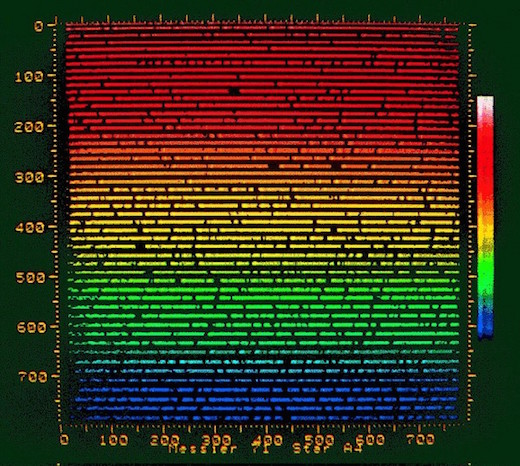
Echelle spectrum as it would have shown in the display of the Hamilton Spectrograph back in the 90s.
The next big breakthrough in the project was led by Steve Vogt. Vogt had recently completed the design and construction of the HIRES echelle spectrometer for the Keck 10-m telescope. Based on a number of advances made over the previous decade, he went back to work on the Hamilton echelle. In November 1994 he replaced the spectrometer camera with a new design that he and Harland Epps invented. The new design dramatically improved the resolution of the Hamilton. In addition he replaced the old CCD detector with a next generation detector that was 6 times larger, significantly increasing the amount of spectrum that could be analyzed.
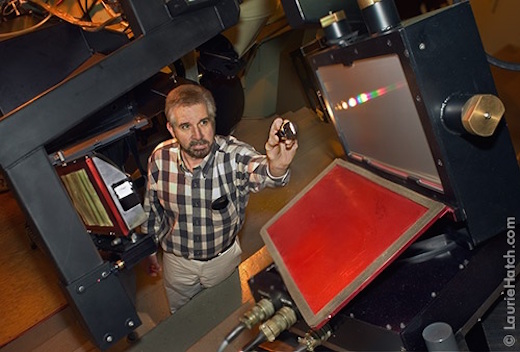
Steve Vogt with the Hamilton Spectrograph inside the Shane 3-meter dome. Image credits : Laurie Hatch 2003 (c), www.lauriehatch.com
After the Hamilton spectrometer upgrade, my effort was focused on the newly emerging higher quality data. By May 1995 the upgraded hardware and software were producing 3 m/s precision. Computer speed continued to be a problem. We had two computers between us. The 8 years of data we had collected would require several years of computer time to analyze.
Breakthrough
At a meeting in Italy during the first week of October 1995 Michel Mayor and Didier Queloz announced the discovery of a very strange planet. 51 Peg b has a mass similar to Jupiter, but orbits its host star in 4 days. While these “hot Jupiters” are now known to be common, at the time nobody had suggested that such planets could exist. Much of the astronomical community as well as the press were skeptical of the claim. We had already been assigned 4 nights of precious time on the Lick Observatory 3-m telescope beginning on the evening of October 11. We observed 51 Peg multiple times each night. I reduced just the 51 Peg data each day, which was all our computers were capable of handling. The observing run concluded on the morning of Sunday October 15. The first 3 nights of data were consistent with the discovery announcement from Mayor and Queloz, but we wanted to see the final night of data before going public. After 4 nights on the mountain, we drove back to Berkeley and crashed. It took our two computers all day to reduce the 51 Peg observations from the final night. We met back at our Berkeley office at midnight. Within a half hour we were able to confirm the discovery of the first extrasolar planet. We put a plot of the 4 nights of data, along with the orbital fit, on the then brand new World Wide Web.
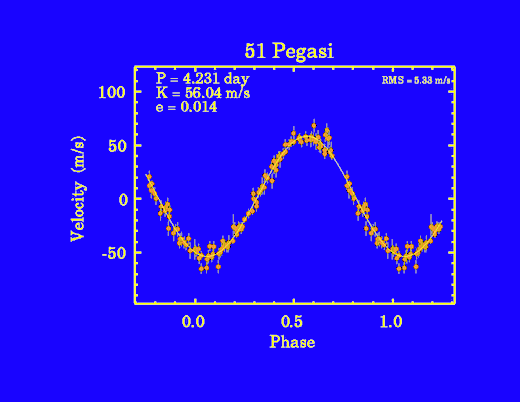
Doppler measurements of 51 Peg from observations were made at Lick Observatory between Oct.11, 1995 and Dec. 1996.
Planet Search Program. No longer was the primary target Jupiter-analogs with 12 year orbital periods. Planets could be found at any orbital period, and could already be embedded in the raw data taken over the previous 8 years. The second change was that the field of extrasolar planets had suddenly become very hot. In the wake of the newspaper and TV publicity that followed the discovery of 51 Peg b, several research groups at UC Berkeley offered the loan of research computers. Shortly thereafter SUN Microsystems made a grant of additional research computers to the Lick Planet Search Program.
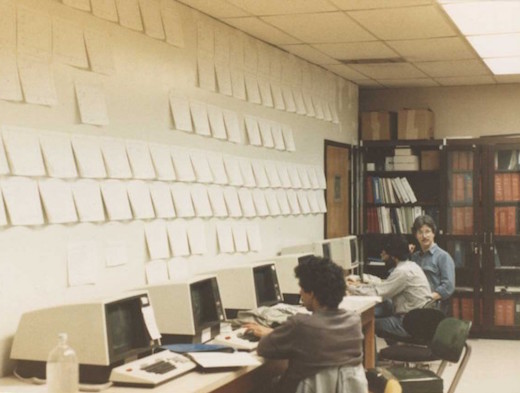
Snapshot of hardworking scientists at San Francisco State University with up-to-date computing facilities of the early 90s.
In late October 1995 I finalized the Doppler velocity reduction analysis, and began analyzing the 8 year backlog of data on an armada of computers that finally topped out at more than 20 machines. Clearing out the backlog of 8 years of data took until June 1996. Analyzing all the observations of a single star could take from half a day to several weeks, depending on how many observations had been taken. Observations taken after Steve Vogt’s upgrade in November 1994 are internally referred to as “post-fix.” The data from the first 7 years is “pre-fix.” These are two separate data sets. Upgrading the camera and the CCD detector made the Hamilton a completely new spectrometer, requiring a completely new Doppler analysis package. Stitching together the “pre-fix” and “post-fix” data sets was a major problem. This problem has re-emerged on most of my subsequent Doppler surveys. By mid-December 1995 hints of planet signals were emerging from the data. At 8 a.m. on the morning of Sunday December 31, I walked into the deserted Berkeley astronomy department to check on the armada of computers. A few jobs had finished, so I loaded the available computers with new stars and looked at the recently analyzed data. The bright nearby star 70 Vir had a whopping signal, the star was being tugged back-and-forth by several hundred meters per second. Within 5 minutes I had fit the data with a Keplerian planetary orbit indicating a 7 Jupiter-mass planet in an 116 day orbit. The signal was so overwhelming that there could be no doubt. This was the first definitive planet to be discovered by the Lick Planet Search Program. After 9 years of working toward this moment, I was stunned, silent. I closed my eyes for several minutes, then looked back at the computer screen. The signal was still there. I did this several times to make sure that the signal did not vanish. In the absolute quiet of a New Years eve Sunday morning I sat for the next hour looking at the signal. For a long time I had the sense that Johannes Kepler was standing over my shoulder, looking at the same signal.
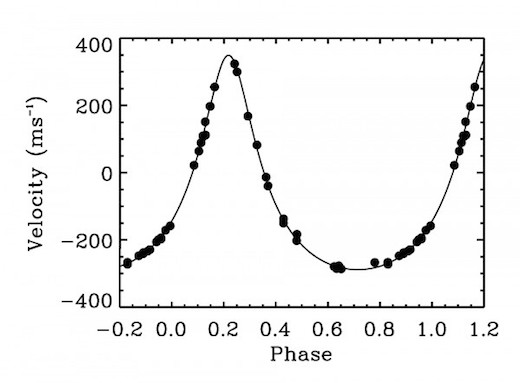
Doppler signal of 70 Vir b, the first planet detected by the Lick Planet Search Program with the iodine cell technique.
Over the next two weeks the case for a planet around 47 UMa firmed up. I solved the problem for putting together the pre-fix and post-fix data. The improved precision of the post-fix data sat on the pre-fix planet prediction like pearls on a string. We announced the planets around 70 Vir and 47 UMa at the winter meeting of the American Astronomical Society in San Antonio, Texas, on January 17, 1996. The story received significant press coverage, including the front page of the NY Times, Washington Post, and the cover of Time magazine.
Over the next 5 months the armada of computers ground through the 9 years of Lick observations. The next 4 planets quickly emerged, including the planets around rho 1 Cnc, tau Boo, nu And, and 16 Cyg B. The Lick Planet Search Program continued to churn out planets over the next decade. A few highlights include the discovery of the planet around an M (red) dwarf star (GL 876) in 1998, and first multiple planet system orbiting nu And in 1999. Our planet search programs at the Lick, Keck, Anglo-Australian, and Magellan Observatories have subsequently found hundreds of planets, including the first transiting planet, the first Saturn-mass planet, the first Neptune-mass planet, and the first Super-earths.
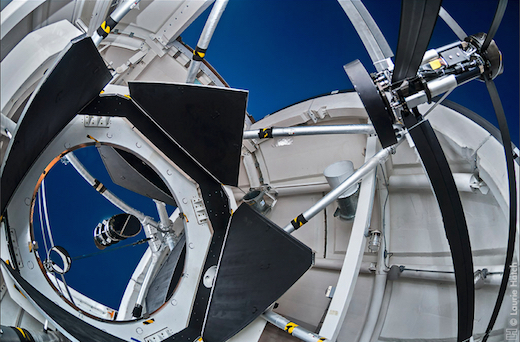
The camera is positioned near the 2.4-meter primary mirror in the dome of the Automated Planet Finder (APF) Telescope at Lick Observatory. At upper right is the secondary mirror. APF is fully robotic, and equipped with a high-resolution spectrograph (designed by Steve Vogt) optimized for precision Doppler measurements. Laurie Hatch 2009 (c), www.lauriehatch.com
After a decade of work, teams at the Carnegie Observatories (Stephen Shectman, Jeff Crane, Ian Thompson) and Lick Observatory (Steve Vogt) have inaugurated the first two purpose built precision velocity spectrometers used with iodine cells. These instruments (PFS at Magellan and APF at Lick) are producing precision of 1 m/s. Our Lick and Carnegie teams are enthusiastic about the next decade. Over the past 25 years the iodine absorption cell has become a standard tool for measuring stellar Doppler velocities. Teams from many institutions such as University of Texas, Penn State, Yale, Harvard; and national and international facilities from Japan, China, Australia, the European Southern Observatory (VLT/UVES), have adopted the iodine technique.
The most exciting discoveries are yet to come.
Written by Paul Butler, Staff Scientist at DTM
This article by Paul Butler originally appeared in Pale Red Dot, 27 March 2016
- - - - -
